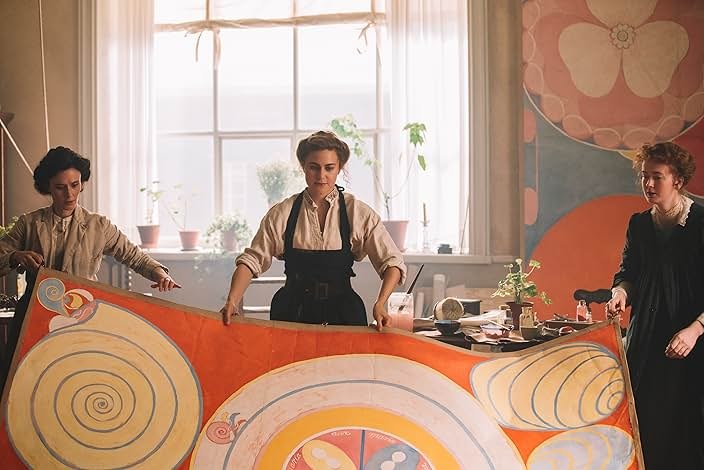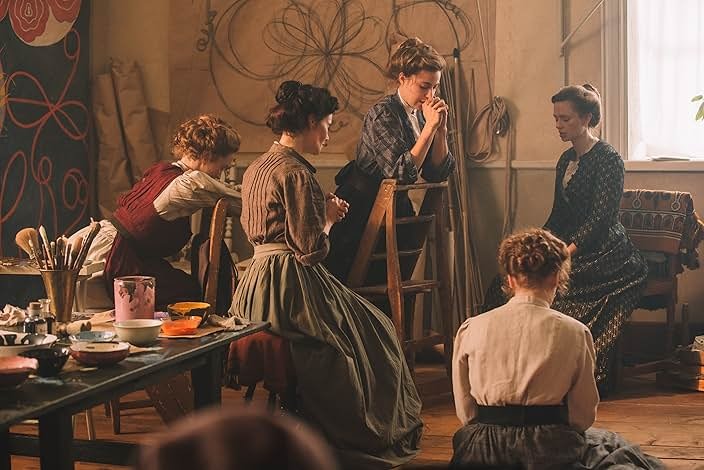Hilma | Biopic of the pioneer in abstract art | Biopic de la pionera en arte abstracto
Welcome 💖 Bienvenidos

This is a biopic about Hilma af Klint, who was the pioneer of abstract art. This is the second film they have made to tell her story and how her work transcended decades after her death. She was born in the 18th century and lived in Stockholm, Sweden, dying at an advanced age.
As a young girl, she was cheerful and enjoyed nature and her family, she was very close to her younger sister who died at the age of 10, causing Hilma a deep depression, turning to spirituality that later became spiritualism, metaphysics and occult studies with the only hope of having contact with her sister and see what is behind death.
She devoted all her feelings of sadness to painting, a passion that she developed from a young age when she was academically trained in art, belonging to the first generation of female artists of her time. Hilma is an advanced woman in all aspects, she believed in free love, without ties, she had a long relationship with a friend, also an artist and part of the group of the five. This group was integrated to live diverse spiritual and artistic experiences following the guidance of Hilma who was the one who received instructions from a voice when she entered into meditation, in her interviews she said that she let herself be carried away by high masters who painted through her, using their brushes; that is why her works never had drafts or preliminary drawings, they included geometric figures and symbols that today are known to be references of the cosmos, all with vibrant colors.
! [Spanish Version]
Es una película biográfica sobre Hilma af Klint, quien fue la pionera del arte abstracto. Esta es la segunda película que hacen para contar su historia y cómo su obra trascendió décadas después de su muerte. Nació en el siglo XVIII y vivió en Estocolmo, Suecia, falleciendo a una edad avanzada.
Cuando joven, era alegre y disfrutaba de la naturaleza y su familia, era muy unida a su hermana menor quien murió a los 10 años, causando en Hilma una depresión profunda avocándose a la espiritualidad que más adelante se convirtió en espiritismo, metafísica y estudios de ciencias ocultas con la única esperanza de tener contacto con su hermana y ver lo que hay detrás de la muerte.
Abocó todo su sentimiento de tristeza en la pintura, pasión que desde joven desarrolló al formarse académicamente en arte, perteneciendo a la primera generación de artistas mujeres de su época. Hilma es una mujer adelantada en todos los aspectos, creía en el amor libre, sin ataduras, tuvo una relación larga con una amiga, también artista y parte del grupo de las cinco. Este grupo se integró para vivir diversas experiencias espirituales y artísticas siguiendo la orientación de Hilma quien era la que recibía instrucciones de una voz cuando entraba en meditación, en sus entrevistas decía que se dejaba llevar por altos maestros que pintaban a través de ella, usando sus pinceles; por eso sus obras nunca tuvieron borradores o dibujos preliminares, están incluían figuras geométricas y símbolos que hoy día se saben que son referencias del cosmos, todos con colores vibrantes.

In the early years Hilma's work got funding to create her art, but it was not to the public's taste at that time, landscapes and family and personal paintings were more appreciated, so she was criticized, but she continued with the conviction that her art were messages from the gods or beings from other worlds and that someday the message would be deciphered. She built a glass house in the countryside that was her religious temple and studio. Her friends abandoned them and she was left alone to guard all her paintings.
Hilma was a sensitive woman who greatly admired a writer of the spiritual current, but every time she tried to show him her paintings and tell him the mystery behind her inspiration, she ended up disappointed by the bad treatment and lack of respect towards her work and personal life.
She had a vision of the future, she described a building with high walls and metallic windows where her works were exhibited, a fact that materialized decades after her death, I was left wondering if this museum was built to give relevance to her stories as part of publicity in her art or if that had nothing to do with it. There was a person who advised her to show her paintings 50 years after her death so that they could be understood, she followed his advice, but decided to do it 20 years later. Today, she is recognized as the pioneer of abstract art.
About the film I can say that it is simple, it has no unexpected twists and its pace is slow, Hilma's character shows how the passion that is exercised can absorb life, a common characteristic in most painters, while watching it I felt uncomfortable, sad and confused, like the protagonist when she showed the feelings of frustration and helplessness of not being understood. In the end I believe that Hilma achieved a connection with the universal consciousness.
! [Spanish Version]
Los primeros años el trabajo de Hilma consiguió financiamiento para crear su arte, pero no era del gusto del público en esa época se apreciaban más los paisajes y las pinturas familiares y personales, por lo que fue criticada, pero ella seguía con la convicción de que su arte eran mensajes de los dioses o de seres de otros mundos y que algún día se descifraría el mensaje. Construyó una casa de cristal en el campo que era su templo religioso y su estudio. Las amigas las abandonaron y ella se quedó sola resguardando todas sus pinturas.Hilma era una mujer sensible que admiraba mucho a un escritor de la corriente espiritual, pero cada vez que intentaba mostrarle sus pinturas y contar el misterio detrás de su inspiración, terminaba decepcionada por el mal trato y la falta de respeto hacia su obra y vida personal.
Ella tenía una visión del futuro, describía un edificio de paredes altas y ventanas metalizadas donde eran exhibidas sus obras, hecho que se materializó décadas después de su muerte, me quedó la incógnita de saber si este museo fue construido para darle relevancia a sus relatos como parte de publicidad en su arte o si eso no tuvo nada que ver. Hubo una persona que le aconsejó mostrar sus pinturas 50 años después de su muerte para que fueran comprendidas, ella siguió su consejo, pero decidió hacerlo 20 años después. Actualmente, es reconocida como la pionera del arte abstracto.
Sobre la película puedo decir que es simple, no tiene giros inesperados y su ritmo es lento, el personaje de Hilma muestra cómo la pasión que se ejerce puede absorber la vida, una característica común en las mayorías de los pintores, mientras la veía me sentí incómoda, triste y confundida, como la protagonista cuando mostraba los sentimientos de frustración e impotencia de no ser comprendida. Al final yo creo que Hilma lograba una conexión con la consciencia universal.


Las películas biográficas generalmente son lentas y sin giros, pero buenas para aprender de cultura general.
Eso es verdad, totalmente, sino fuera por el cine no me hubiese enterado de esta artista.